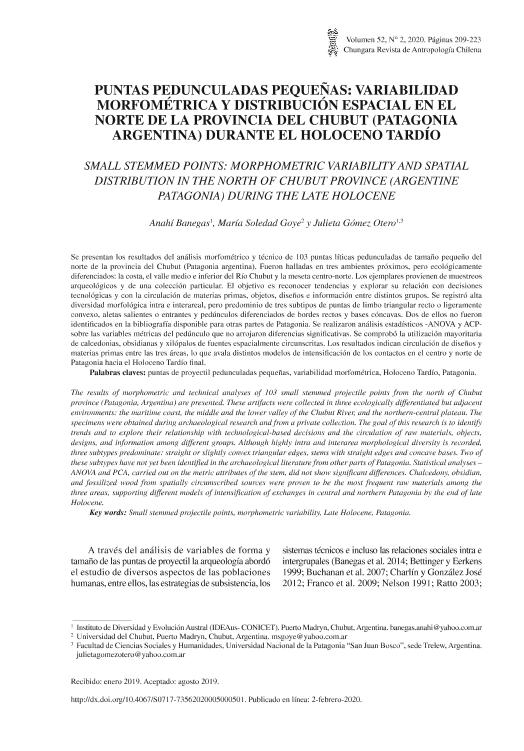Artículo
Se presentan los resultados del análisis morfométrico y técnico de 103 puntas líticas pedunculadas de tamaño pequeño del norte de la provincia del Chubut (Patagonia argentina). Fueron halladas en tres ambientes próximos pero ecológicamente diferenciados: la costa, el valle medio e inferior del río Chubut y la meseta centro-norte. Los ejemplares provienen de muestreos arqueológicos y de una colección particular. El objetivo es reconocer tendencias y explorar su relación con decisiones tecnológicas y con la circulación de materias primas, objetos, diseños e información entre distintos grupos. Se registró alta diversidad morfológica intra e interareal, pero predominio de tres subtipos de puntas de limbo triangular recto o ligeramente convexo, aletas salientes o entrantes y pedúnculos diferenciados de bordes rectos y bases cóncavas. Dos de ellos no fueron identificados en la bibliografía disponible para otras partes de Patagonia. Se realizaron análisis estadísticos -ANOVA y ACP- sobre las variables métricas del pedúnculo que no arrojaron diferencias significativas. Se comprobó la utilización mayoritaria de calcedonias, obsidianas y xilópalos de fuentes espacialmente circunscriptas. Los resultados indican circulación de diseños y materias primas entre las tres áreas, lo que avala distintos modelos de intensificación de los contactos en el centro y norte de Patagonia hacia el Holoceno tardío final. The results of morphometric and technical analyses of 103 small stemmed projectile points from the north of Chubut province (Patagonia, Argentina) are presented. These artifacts were collected in three ecologically differentiated but adjacent environments: the maritime coast, the middle and the lower valley of the Chubut River, and the northern-central plateau. The specimens were obtained during archaeological research and from a private collection. The goal of this research is to identify trends and to explore their relationship with technological-based decisions and the circulation of raw materials, objects, designs, and information among different groups. Although highly intra and interarea morphological diversity is recorded, three subtypes predominate: straight or slightly convex triangular edges, stems with straight edges and concave bases. Two of these subtypes have not yet been identified in the archaeological literature from other parts of Patagonia. Statistical analyses –ANOVA and PCA, carried out on the metric attributes of the stem, did not show significant differences. Chalcedony, obsidian, and fossilized wood from spatially circumscribed sources were proven to be the most frequent raw materials among the three areas, supporting different models of intensification of exchanges in central and northern Patagonia by the end of late Holocene.
Puntas pedunculadas pequeñas: variabilidad de diseños y distribución espacial en el norte de la provincia del Chubut (Patagonia argentina) durante el Holoceno Tardío
Título:
Small Stemmed Points: Morphometric Variability and Spatial Distribution in the North of Chubut Province (Argentine Patagonia) during the Late Holocene
Fecha de publicación:
03/2021
Editorial:
Universidad de Tarapacá
Revista:
Chungará. Revista de Antropología Chilena
ISSN:
0716-1182
e-ISSN:
0717-7356
Idioma:
Español
Tipo de recurso:
Artículo publicado
Clasificación temática:
Resumen
Archivos asociados
Licencia
Identificadores
Colecciones
Articulos(IDEAUS)
Articulos de INSTITUTO DE DIVERSIDAD Y EVOLUCION AUSTRAL
Articulos de INSTITUTO DE DIVERSIDAD Y EVOLUCION AUSTRAL
Citación
Banegas, Anahi; Goye, Maria Soledad; Gomez Otero, Julieta; Puntas pedunculadas pequeñas: variabilidad de diseños y distribución espacial en el norte de la provincia del Chubut (Patagonia argentina) durante el Holoceno Tardío; Universidad de Tarapacá; Chungará. Revista de Antropología Chilena; 52; 2; 3-2021; 209-223
Compartir
Altmétricas




